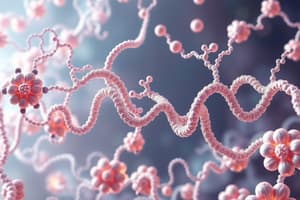Podcast
Questions and Answers
Which of the following best describes the energy requirements for transporting an uncharged molecule against its concentration gradient?
Which of the following best describes the energy requirements for transporting an uncharged molecule against its concentration gradient?
- Only occurs if the molecule is transported via channels.
- Requires energy input due to the movement against the concentration gradient. (correct)
- Is solely dependent on the temperature of the environment.
- Requires no energy input because the molecule is uncharged.
In the context of cellular transport, what is the fundamental difference between active and passive transport?
In the context of cellular transport, what is the fundamental difference between active and passive transport?
- Active transport uses channels, while passive transport uses carriers.
- Active transport requires energy input, while passive transport does not (though energy is required to establish the gradient). (correct)
- Active transport moves substances down the electrochemical gradient, while passive transport moves substances against it.
- Passive transport is facilitated by ATPases, while active transport relies on light energy.
How is the sodium/potassium pump categorized in terms of energy coupling?
How is the sodium/potassium pump categorized in terms of energy coupling?
- Voltage-gated
- ATPase (correct)
- Light-driven
- Redox-driven
Which of the following transport mechanisms is LEAST likely to be involved in active transport?
Which of the following transport mechanisms is LEAST likely to be involved in active transport?
Considering the relationship between active and passive transport, what is the most accurate statement?
Considering the relationship between active and passive transport, what is the most accurate statement?
An uncharged molecule is transported across a membrane. What primarily determines its movement?
An uncharged molecule is transported across a membrane. What primarily determines its movement?
A cation is being transported across a cell membrane. Which factor would increase the rate of its transport into the cell?
A cation is being transported across a cell membrane. Which factor would increase the rate of its transport into the cell?
In Case 3, an anion's net driving force depends on the size between chemical and electrical gradients. If the anion's chemical gradient directs it out of the cell, but the electrical gradient drives it into the cell, under what condition will the anion move into the cell?
In Case 3, an anion's net driving force depends on the size between chemical and electrical gradients. If the anion's chemical gradient directs it out of the cell, but the electrical gradient drives it into the cell, under what condition will the anion move into the cell?
Consider an anion with a higher concentration outside the cell and a positive membrane potential (outside is positive). What must be true for the anion to move out of the cell?
Consider an anion with a higher concentration outside the cell and a positive membrane potential (outside is positive). What must be true for the anion to move out of the cell?
Which of the following scenarios would result in the smallest net driving force on a charged ion?
Which of the following scenarios would result in the smallest net driving force on a charged ion?
A cell needs to transport potassium ions (K+) across its membrane. Considering both chemical and electrical gradients, which statement best describes the challenge the cell faces?
A cell needs to transport potassium ions (K+) across its membrane. Considering both chemical and electrical gradients, which statement best describes the challenge the cell faces?
Which of the following characteristics of transport proteins is LEAST likely to contribute to the 'controlled' interaction of a cell with its environment?
Which of the following characteristics of transport proteins is LEAST likely to contribute to the 'controlled' interaction of a cell with its environment?
If a cell membrane suddenly became freely permeable to all ions, which of the following would most likely occur?
If a cell membrane suddenly became freely permeable to all ions, which of the following would most likely occur?
In a scenario where the concentration of chloride ions (Cl-) is higher inside a cell compared to the outside, and assuming there's a negative electrical potential inside the cell, what would be the likely movement of chloride ions?
In a scenario where the concentration of chloride ions (Cl-) is higher inside a cell compared to the outside, and assuming there's a negative electrical potential inside the cell, what would be the likely movement of chloride ions?
A researcher discovers a new transport protein that significantly increases the rate of glucose transport into a cell, but only when the cell is actively performing aerobic respiration. Which property is this transport protein most likely to possess?
A researcher discovers a new transport protein that significantly increases the rate of glucose transport into a cell, but only when the cell is actively performing aerobic respiration. Which property is this transport protein most likely to possess?
In the context of cellular membrane transport, what is the key difference between active and passive transport?
In the context of cellular membrane transport, what is the key difference between active and passive transport?
If a cell needs to transport a solute against its electrochemical gradient, which type of transport mechanism is required?
If a cell needs to transport a solute against its electrochemical gradient, which type of transport mechanism is required?
What is the primary role of pumps in establishing electrochemical gradients across cellular membranes?
What is the primary role of pumps in establishing electrochemical gradients across cellular membranes?
Which of the following best describes the 'gating' mechanism of ion channels?
Which of the following best describes the 'gating' mechanism of ion channels?
During a patch-clamp experiment, what is the function of the suction pipette?
During a patch-clamp experiment, what is the function of the suction pipette?
Which of the following best describes the primary role of bacteriorhodopsin?
Which of the following best describes the primary role of bacteriorhodopsin?
How do pumps contribute to establishing electrochemical gradients?
How do pumps contribute to establishing electrochemical gradients?
In co-transport systems, what distinguishes a symporter from an antiporter?
In co-transport systems, what distinguishes a symporter from an antiporter?
The salt bush (Atriplex) uses salt bladders to remove excess Na+ from its cells. Which transport system is most likely involved in this process?
The salt bush (Atriplex) uses salt bladders to remove excess Na+ from its cells. Which transport system is most likely involved in this process?
How do transport proteins facilitate passive transport?
How do transport proteins facilitate passive transport?
What is the primary difference between channels and carriers in passive transport?
What is the primary difference between channels and carriers in passive transport?
A cell needs to import glucose against its concentration gradient. Which mechanism would it most likely utilize?
A cell needs to import glucose against its concentration gradient. Which mechanism would it most likely utilize?
Why do some potassium (K+) channels exhibit a 100-fold higher permeability for K+ than for sodium (Na+)?
Why do some potassium (K+) channels exhibit a 100-fold higher permeability for K+ than for sodium (Na+)?
Flashcards
Membrane Transport
Membrane Transport
The process of moving molecules across biological membranes.
Transport Proteins
Transport Proteins
Proteins that facilitate the movement of substances across a cell membrane.
Facilitated Diffusion
Facilitated Diffusion
A type of passive transport that uses transport proteins to move molecules across membranes.
Electrochemical Gradient
Electrochemical Gradient
Signup and view all the flashcards
Permeability
Permeability
Signup and view all the flashcards
Chemical Gradient
Chemical Gradient
Signup and view all the flashcards
Electrical Gradient
Electrical Gradient
Signup and view all the flashcards
Net Driving Force
Net Driving Force
Signup and view all the flashcards
Cation
Cation
Signup and view all the flashcards
Anion
Anion
Signup and view all the flashcards
Energy Investment
Energy Investment
Signup and view all the flashcards
Active Transport
Active Transport
Signup and view all the flashcards
Passive Transport
Passive Transport
Signup and view all the flashcards
Transport Proteins: Active vs Passive
Transport Proteins: Active vs Passive
Signup and view all the flashcards
Sodium/Potassium Pump
Sodium/Potassium Pump
Signup and view all the flashcards
Bacteriorhodopsin
Bacteriorhodopsin
Signup and view all the flashcards
Conformational Change
Conformational Change
Signup and view all the flashcards
Proton Pump
Proton Pump
Signup and view all the flashcards
Co-Transporter
Co-Transporter
Signup and view all the flashcards
Symport System
Symport System
Signup and view all the flashcards
Antiport System
Antiport System
Signup and view all the flashcards
Gated Ion Channels
Gated Ion Channels
Signup and view all the flashcards
Patch Clamp Technique
Patch Clamp Technique
Signup and view all the flashcards
Electrochemical Gradient Effects
Electrochemical Gradient Effects
Signup and view all the flashcards
Study Notes
Membrane Transport
- Membrane transport is NOT the movement of membranes themselves.
- It involves the movement of molecules, especially ions, across biological membranes.
- Also called 'trans'-membrane transport, ion transport, or nutrient transport.
Importance of Membrane Transport
- Necessary for protecting metabolic reactions inside cells from the environment.
- Essential for communication and material exchange between the cell and its environment.
- Transport proteins within the cell membrane control interactions between cells and the environment.
Membrane Permeability
- Highly permeable to small hydrophobic molecules and gases (e.g., oxygen).
- Limited permeability to water.
- Very low permeability to ions (e.g., potassium) and large solutes (e.g., glucose).
Transport Proteins
- Create hydrophilic passages.
- Act as filters.
- Enable energy coupling (where energy is linked to transport).
- Allow for regulation.
Facilitated Diffusion
- Transport proteins form a hydrophilic pore.
- Molecules diffuse through this pore.
- Example: aquaporins (water channels).
Driving Forces for Solute Transport
- Chemical gradient: Difference in solute concentration.
- Electrical gradient: Difference in charge.
- Only relevant to charged molecules (ions).
- Cations: Examples include proton (H+), potassium (K+), ammonium (NH₄⁺), histidine, and spermidine.
- Anions: Examples include chloride (Cl⁻), nitrate (NO₃⁻), glutamate, malate, and pyruvate.
Electrochemical Gradient
- The net driving force for a molecule’s movement, resulting from the combination of chemical and electrical gradients.
- Direction depends on the relative strengths of the chemical and electrical gradients, considering if the molecule is charged or uncharged.
Energy Requirements of Transport
- Electrochemical gradients determine energy needed for transport.
- Energy investment is needed to move molecules against gradients (active transport).
- Energy is gained when moving molecules down gradients (passive transport).
Active and Passive Transport
- Active transport: Moves substances against the electrochemical gradient; requires energy input.
- Passive transport: Moves substances down the electrochemical gradient; requires no energy input, but still depends on previously established gradients.
- Active transport is a prerequisite for passive transport, as the gradients are established by active transport.
Transport Proteins for Active and Passive Transport
- Transport proteins for active transport: Pumps, co-transport systems
- Transport proteins for passive transport: Channels, carriers
Pumps (Active Transport)
- Energy coupling: ATP is used to power transport.
- Examples of pumps: Sodium/potassium pumps, proton pumps, calcium pumps
- e.g. Sodium/potassium pump transporter proteins bind 3 Na+ from inside the cell, get phosphorylated, releases 3 Na+, binds 2 K+ from outside the cell, dephosphorylated, releases 2K+ inside the cell.
Co-transport Systems (Active Transport)
- Couple the movement of one ion (driver) to the uphill movement of another solute (subscriber).
- Symport: Driver ion and substrate move in the same direction.
- Antiport: Driver ion and substrate move in opposite directions.
Transport Coupling
- Primary pumps use with co-transport systems in all life forms and function in organelles and cells.
- Example: Na⁺/K⁺ ATPase and Na⁺-driven symport
Passive Transport (cont.)
- Movement of substances down the electrochemical gradient.
- Relies on previously set electrochemical gradients.
- Transport proteins for passive transport: Channels, carriers
- Channels: create an aqueous pore for ion passage
- Carriers: undergo conformational changes to expose binding sites to the membrane's different surfaces, allowing molecules to move through.
Ion Channels
- Exist as selective and gated pathways.
- Selective permeability, e.g., K⁺ channels much more permeable to K⁺ than Na⁺.
- Gated channels open/close in response to stimuli like voltage changes or ligand binding
- An example of a gated channel would be voltage-gated channels which open and close in response to changes in membrane potential.
Measuring Ion Channels
- Patch-clamp measurement allow for measuring how single channel proteins gate.
- Equipment includes suction pipette and amplifier.
Studying That Suits You
Use AI to generate personalized quizzes and flashcards to suit your learning preferences.





